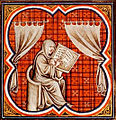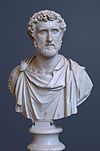Portal:Biography
The Biography Portal
A biography, or simply bio, is a detailed description of a person's life. It involves more than just basic facts like education, work, relationships, and death; it portrays a person's experience of these life events. Unlike a profile or curriculum vitae (résumé), a biography presents a subject's life story, highlighting various aspects of their life, including intimate details of experience, and may include an analysis of the subject's personality.
Biographical works are usually non-fiction, but fiction can also be used to portray a person's life. One in-depth form of biographical coverage is called legacy writing. Works in diverse media, from literature to film, form the genre known as biography.
An authorized biography is written with the permission, cooperation, and at times, participation of a subject or a subject's heirs. An autobiography is written by the person themselves, sometimes with the assistance of a collaborator or ghostwriter. (Full article...)
Featured biographies –
During the seven years in which he was active, Joehana wrote a number of stories and articles, as well as several novels. The years of publication are generally unclear, as reprints included neither the year of first publication nor the printing number. Stylistically, Joehana has been classified as a realist owing to his use of the names of actual locations and products in his works, as well as the predominantly vernacular Sundanese in his novels. However, influences from traditional theatrical forms such as wayang and literature such as pantun are evident. Joehana's works cover a wide range of themes, although in general they are oriented towards social criticism and promote modernization. (Full article...)
The Mercury Seven were the group of seven astronauts selected to fly spacecraft for Project Mercury. They are also referred to as the Original Seven and Astronaut Group 1. Their names were publicly announced by NASA on April 9, 1959: Scott Carpenter, Gordon Cooper, John Glenn, Gus Grissom, Wally Schirra, Alan Shepard, and Deke Slayton. The Mercury Seven created a new profession in the United States, and established the image of the American astronaut for decades to come.
All of the Mercury Seven eventually flew in space. They piloted the six spaceflights of the Mercury program that had an astronaut on board from May 1961 to May 1963, and members of the group flew on all of the NASA human spaceflight programs of the 20th century – Mercury, Gemini, Apollo, and the Space Shuttle. (Full article...)
The Supremes were an American girl group and a premier act of Motown Records during the 1960s. Founded as the Primettes in Detroit, Michigan, in 1959, the Supremes were the most commercially successful of Motown's acts and the most successful American vocal band, with 12 number-one singles on the Billboard Hot 100. Most of these hits were written and produced by Motown's main songwriting and production team, Holland–Dozier–Holland. It is said that their breakthrough made it possible for future African-American R&B and soul musicians to find mainstream success. Billboard ranked the Supremes as the 16th greatest Hot 100 artist of all time.
Florence Ballard, Mary Wilson, Diana Ross, and Betty McGlown, the original members, were all from the Brewster-Douglass public housing project in Detroit. They formed the Primettes as the sister act to the Primes (with Paul Williams and Eddie Kendricks, who went on to form the Temptations). Barbara Martin replaced McGlown in 1960, and the group signed with Motown the following year as the Supremes. Martin left the act in early 1962, and Ross, Ballard, and Wilson continued as a trio. (Full article...)
Martin Rundkvist (born 4 April 1972) is a Swedish archaeologist and associate professor at the University of Łódź in Poland. His research focuses on the Bronze, Iron, and Middle Ages of Scandinavia, including significant excavations in the province of Östergötland.
Rundkvist has studied and excavated various sites in Sweden, particularly in the country's south. In 2003 and 2004, he published a three-volume work which doubled as his PhD dissertation, cataloguing the finds from Barshalder, the largest prehistoric cemetery on the Swedish island of Gotland. A subsequent book identified nine possible regional power centres in Östergötland, and attempted to determine where the "Beowulfian mead halls" of the day once stood. Excavating years later at one of these sites, Aska, Rundkvist uncovered the foundations of a large mead hall, and 30 ornate gold figures that might have represented gods or royals. In other works, Rundkvist has excavated a Viking boat grave, and analysed both the placement of deposited artefacts in the landscape and the lifestyles of the Scandinavian élite during the Middle Ages. (Full article...)
James II and VII (14 October 1633 O.S. – 16 September 1701) was King of England and Ireland as James II and King of Scotland as James VII from the death of his elder brother, Charles II, on 6 February 1685, until he was deposed in the 1688 Glorious Revolution. The last Catholic monarch of England, Scotland, and Ireland, his reign is now remembered primarily for conflicts over religion. However, it also involved struggles over the principles of absolutism and divine right of kings, with his deposition ending a century of political and civil strife by confirming the primacy of the English Parliament over the Crown.
James succeeded to the throne with widespread support, largely due to a reluctance to undermine the principle of heredity succession, and the belief that a Catholic monarchy was purely temporary. However, tolerance of his personal views did not extend to Catholicism in general, and both the English and Scottish parliaments refused to pass measures viewed as undermining the primacy of the Protestant religion. His attempts to impose them by decree met with opposition, and as a result, it has been argued it was a political principle, rather than a religious one, that ultimately led to his removal. (Full article...)
Air Commodore Arthur Henry Cobby, CBE, DSO, DFC & Two Bars, GM (26 August 1894 – 11 November 1955) was an Australian military aviator. He was the leading fighter ace of the Australian Flying Corps (AFC) during World War I, despite seeing active service for less than a year.
Born and educated in Melbourne, Cobby was a bank clerk when war broke out, and was prevented by his employer from enlisting in the Australian Imperial Force until 1916. After completing flight training in England, he served on the Western Front with No. 4 Squadron AFC, operating Sopwith Camels. He was credited with 29 aerial victories, and his achievements were recognised with the Distinguished Service Order, the Distinguished Flying Cross and two bars, and a mention in despatches. (Full article...)
Causantín mac Áeda (Modern Gaelic: Còiseam mac Aoidh, anglicised Constantine II; born no later than 879; died 952) was an early King of Scotland, known then by the Gaelic name Alba. The Kingdom of Alba, a name which first appears in Constantine's lifetime, was situated in what is now Northern Scotland.
The core of the kingdom was formed by the lands around the River Tay. Its southern limit was the River Forth, northwards it extended towards the Moray Firth and perhaps to Caithness, while its western limits are uncertain. Constantine's grandfather Kenneth I (Cináed mac Ailpín, died 858) was the first of the family recorded as a king, but as king of the Picts. This change of title, from king of the Picts to king of Alba, is part of a broader transformation of Pictland and the origins of the Kingdom of Alba are traced to Constantine's lifetime. (Full article...)















































